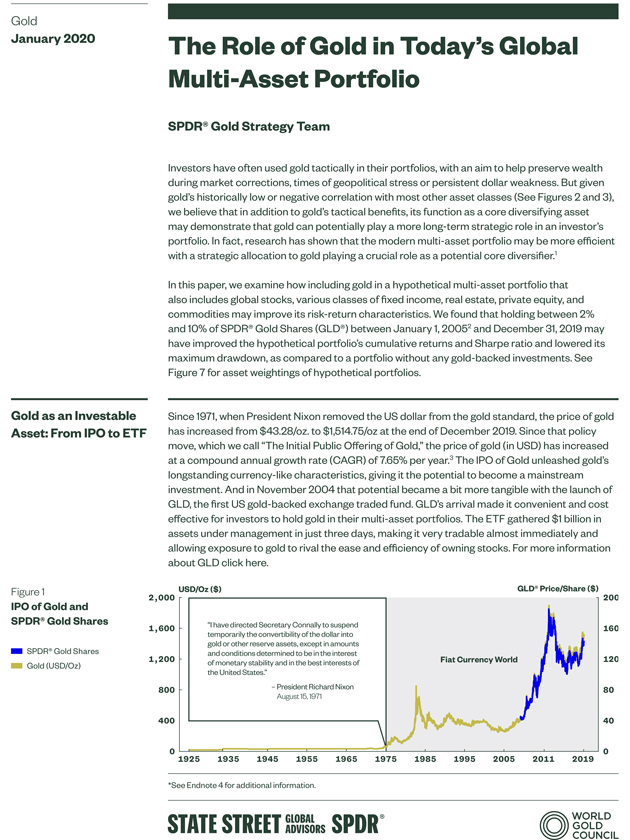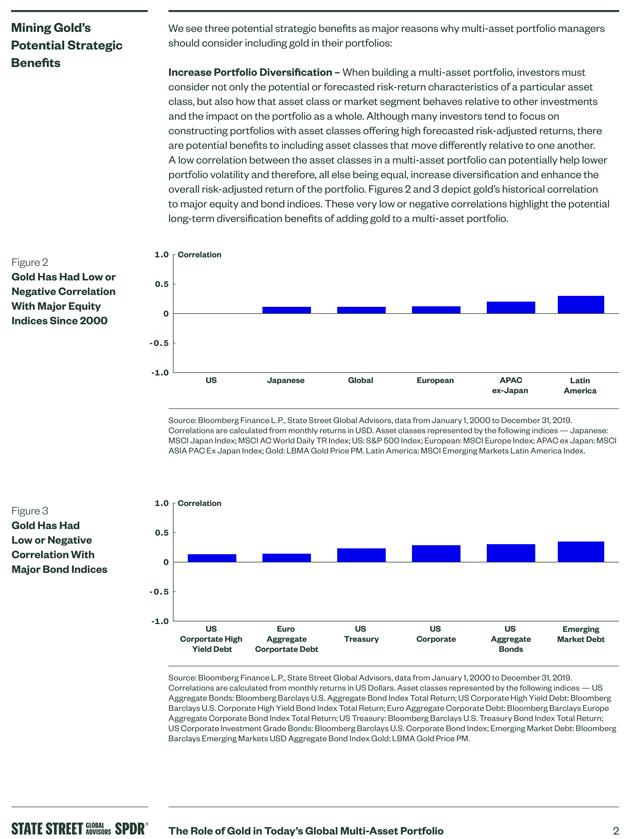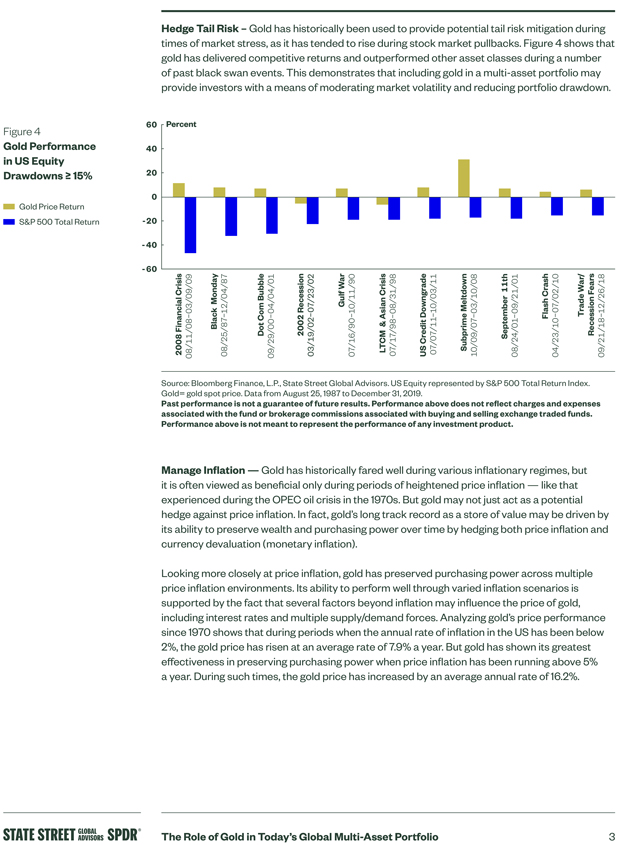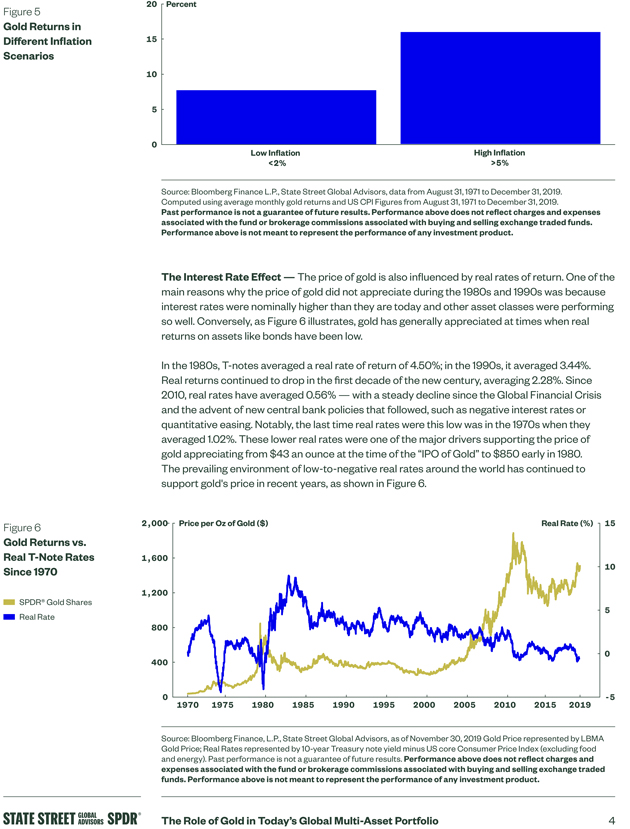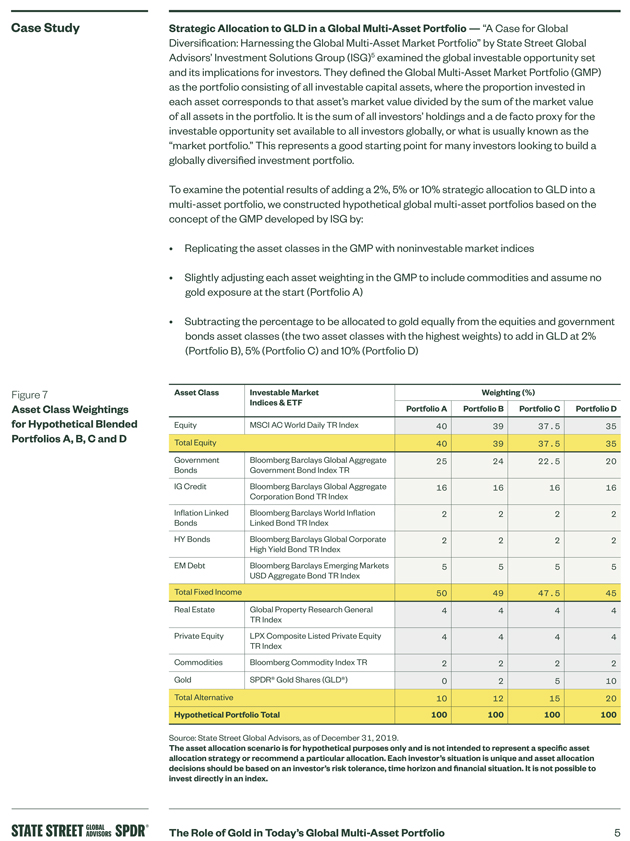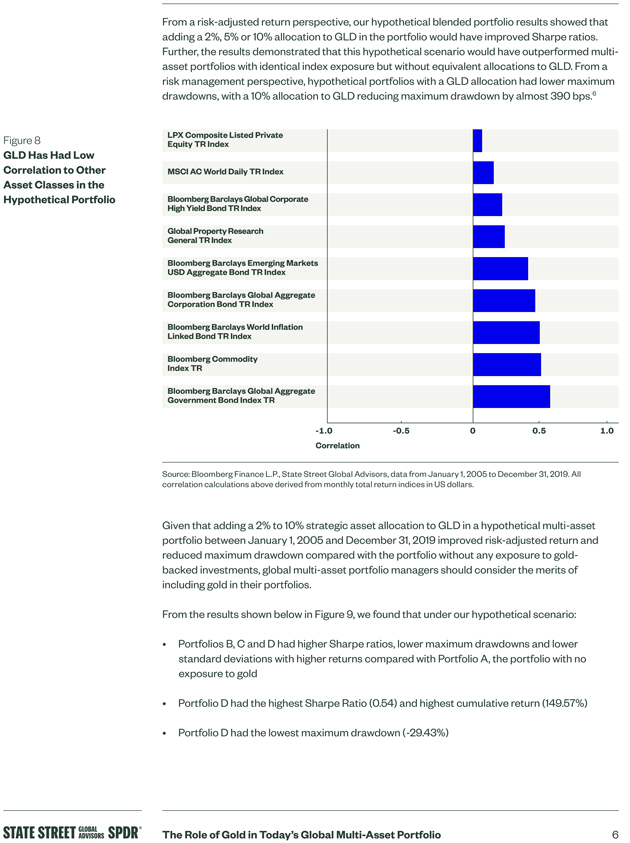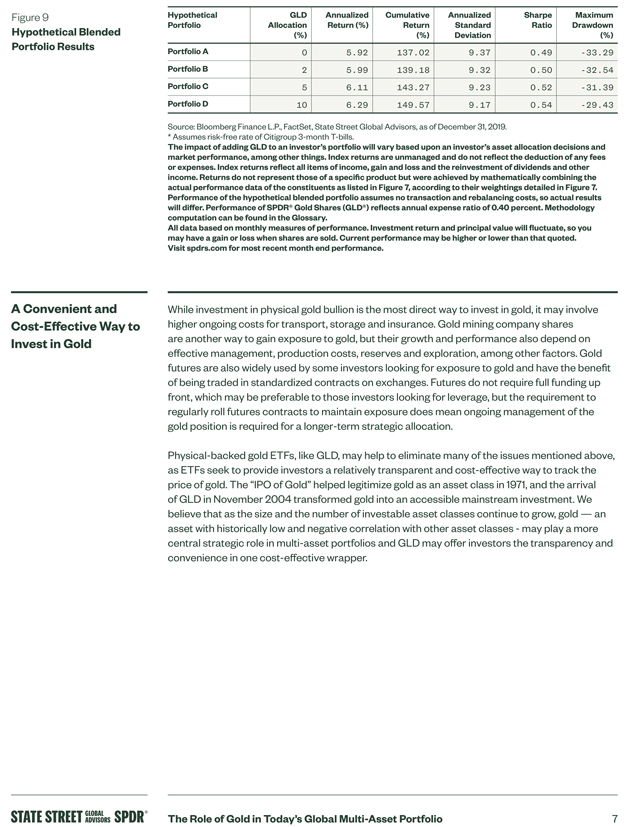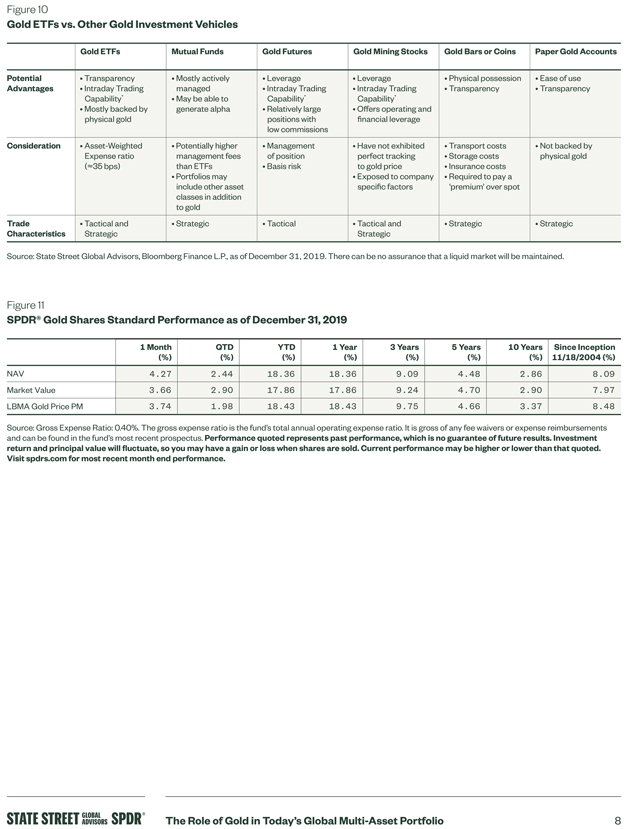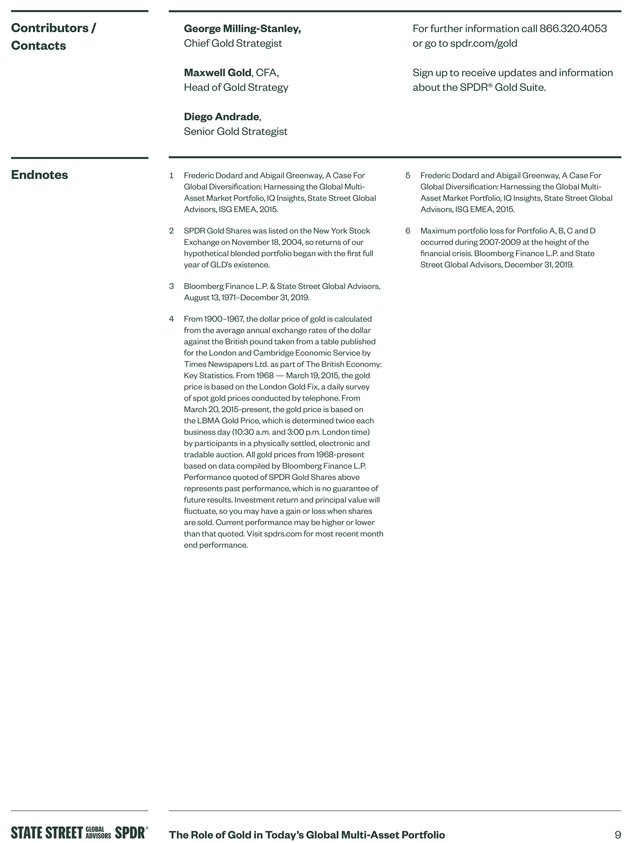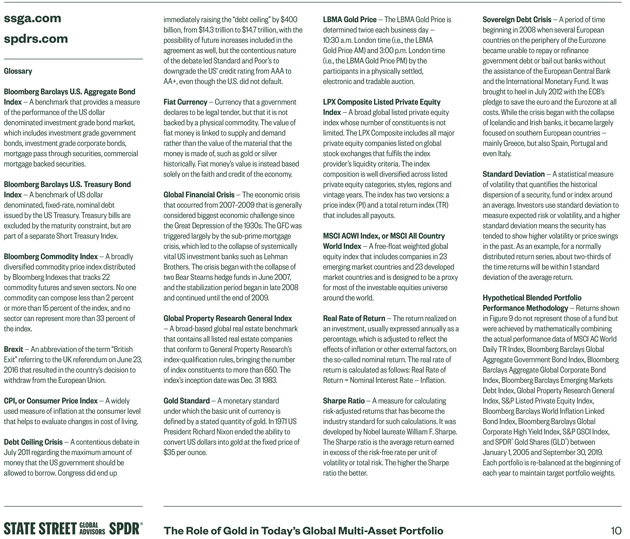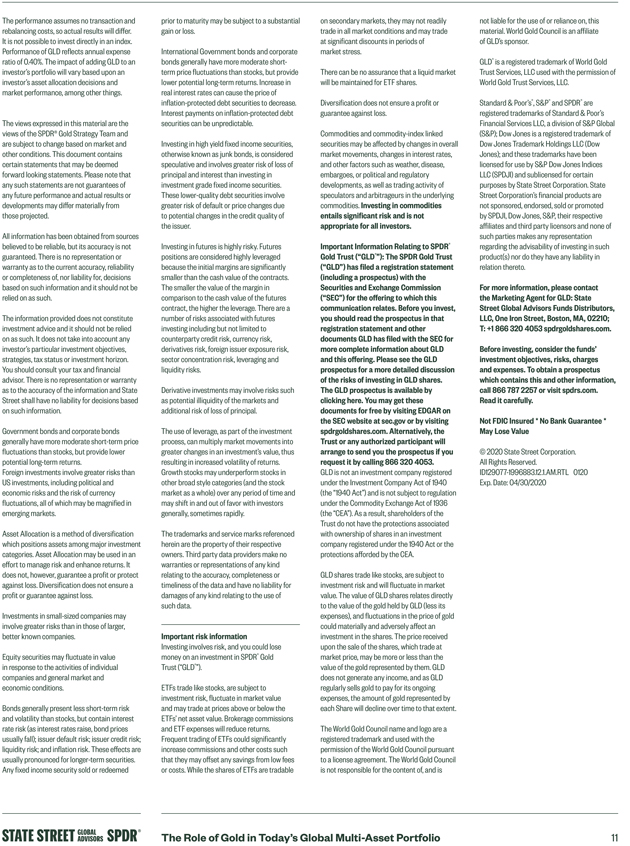
The performance assumes no transaction and rebalancing costs, so actual results will differ. It is not possible to invest directly in an index. Performance of GLD reflects annual expense ratio of 0.40%. The impact of adding GLD to an investor’s portfolio will vary based upon an investor’s asset allocation decisions and market performance, among other things. The views expressed in this material are the views of the SPDR® Gold Strategy Team and are subject to change based on market and other conditions. This document contains certain statements that may be deemed forward looking statements. Please note that any such statements are not guarantees of any future performance and actual results or developments may differ materially from those projected. All information has been obtained from sources believed to be reliable, but its accuracy is not guaranteed. There is no representation or warranty as to the current accuracy, reliability or completeness of, nor liability for, decisions based on such information and it should not be relied on as such. The information provided does not constitute investment advice and it should not be relied on as such. It does not take into account any investor’s particular investment objectives, strategies, tax status or investment horizon. You should consult your tax and financial advisor. There is no representation or warranty as to the accuracy of the information and State Street shall have no liability for decisions based on such information. Government bonds and corporate bonds generally have more moderate short-term price fluctuations than stocks, but provide lower potential long-term returns. Foreign investments involve greater risks than US investments, including political and economic risks and the risk of currency fluctuations, all of which may be magnified in emerging markets. Asset Allocation is a method of diversification which positions assets among major investment categories. Asset Allocation may be used in an effort to manage risk and enhance returns. It does not, however, guarantee a profit or protect against loss. Diversification does not ensure a profit or guarantee against loss. Investments in small-sized companies may involve greater risks than in those of larger, better known companies. Equity securities may fluctuate in value in response to the activities of individual companies and general market and economic conditions. Bonds generally present less short-term risk and volatility than stocks, but contain interest rate risk (as interest rates raise, bond prices usually fall); issuer default risk; issuer credit risk; liquidity risk; and inflation risk. These effects are usually pronounced for longer-term securities. Any fixed income security sold or redeemed prior to maturity may be subject to a substantial gain or loss. International Government bonds and corporate bonds generally have more moderate short-term price fluctuations than stocks, but provide lower potential long-term returns. Increase in real interest rates can cause the price of inflation-protected debt securities to decrease. Interest payments on inflation-protected debt securities can be unpredictable. Investing in high yield fixed income securities, otherwise known as junk bonds, is considered speculative and involves greater risk of loss of principal and interest than investing in investment grade fixed income securities. These lower-quality debt securities involve greater risk of default or price changes due to potential changes in the credit quality of the issuer. Investing in futures is highly risky. Futures positions are considered highly leveraged because the initial margins are significantly smaller than the cash value of the contracts. The smaller the value of the margin in comparison to the cash value of the futures contract, the higher the leverage. There are a number of risks associated with futures investing including but not limited to counterparty credit risk, currency risk, derivatives risk, foreign issuer exposure risk, sector concentration risk, leveraging and liquidity risks. Derivative investments may involve risks such as potential illiquidity of the markets and additional risk of loss of principal. The use of leverage, as part of the investment process, can multiply market movements into greater changes in an investment’s value, thus resulting in increased volatility of returns. Growth stocks may underperform stocks in other broad style categories (and the stock market as a whole) over any period of time and may shift in and out of favor with investors generally, sometimes rapidly. The trademarks and service marks referenced herein are the property of their respective owners. Third party data providers make no warranties or representations of any kind relating to the accuracy, completeness or timeliness of the data and have no liability for damages of any kind relating to the use of such data. Important risk information Investing involves risk, and you could lose money on an investment in SPDR® Gold Trust (“GLD®”). ETFs trade like stocks, are subject to investment risk, fluctuate in market value and may trade at prices above or below the ETFs’ net asset value. Brokerage commissions and ETF expenses will reduce returns. Frequent trading of ETFs could significantly increase commissions and other costs such that they may offset any savings from low fees or costs. While the shares of ETFs are tradable on secondary markets, they may not readily trade in all market conditions and may trade at significant discounts in periods of market stress. There can be no assurance that a liquid market will be maintained for ETF shares. Diversification does not ensure a profit or guarantee against loss. Commodities and commodity-index linked securities may be affected by changes in overall market movements, changes in interest rates, and other factors such as weather, disease, embargoes, or political and regulatory developments, as well as trading activity of speculators and arbitrageurs in the underlying commodities. Investing in commodities entails significant risk and is not appropriate for all investors. Important Information Relating to SPDR® Gold Trust (“GLD®”): The SPDR Gold Trust (“GLD”) has filed a registration statement (including a prospectus) with the Securities and Exchange Commission (“SEC”) for the offering to which this communication relates. Before you invest, you should read the prospectus in that registration statement and other documents GLD has filed with the SEC for more complete information about GLD and this offering. Please see the GLD prospectus for a more detailed discussion of the risks of investing in GLD shares. The GLD prospectus is available by clicking here. You may get these documents for free by visiting EDGAR on the SEC website at sec.gov or by visiting spdrgoldshares.com. Alternatively, the Trust or any authorized participant will arrange to send you the prospectus if you request it by calling 866 320 4053. GLD is not an investment company registered under the Investment Company Act of 1940 (the “1940 Act”) and is not subject to regulation under the Commodity Exchange Act of 1936 (the “CEA”). As a result, shareholders of the Trust do not have the protections associated with ownership of shares in an investment company registered under the 1940 Act or the protections afforded by the CEA. GLD shares trade like stocks, are subject to investment risk and will fluctuate in market value. The value of GLD shares relates directly to the value of the gold held by GLD (less its expenses), and fluctuations in the price of gold could materially and adversely affect an investment in the shares. The price received upon the sale of the shares, which trade at market price, may be more or less than the value of the gold represented by them. GLD does not generate any income, and as GLD regularly sells gold to pay for its ongoing expenses, the amount of gold represented by each Share will decline over time to that extent. The World Gold Council name and logo are a registered trademark and used with the permission of the World Gold Council pursuant to a license agreement. The World Gold Council is not responsible for the content of, and is not liable for the use of or reliance on, this material. World Gold Council is an affiliate of GLD’s sponsor. GLD® is a registered trademark of World Gold Trust Services, LLC used with the permission of World Gold Trust Services, LLC. Standard & Poor’s®, S&P® and SPDR® are registered trademarks of Standard & Poor’s Financial Services LLC, a division of S&P Global (S&P); Dow Jones is a registered trademark of Dow Jones Trademark Holdings LLC (Dow Jones); and these trademarks have been licensed for use by S&P Dow Jones Indices LLC (SPDJI) and sublicensed for certain purposes by State Street Corporation. State Street Corporation’s financial products are not sponsored, endorsed, sold or promoted by SPDJI, Dow Jones, S&P, their respective affiliates and third party licensors and none of such parties makes any representation regarding the advisability of investing in such product(s) nor do they have any liability in relation thereto. For more information, please contact the Marketing Agent for GLD: State Street Global Advisors Funds Distributors, LLC, One Iron Street, Boston, MA, 02210;T: +1 866 320 4053 spdrgoldshares.com. Before investing, consider the funds’ investment objectives, risks, charges and expenses. To obtain a prospectus which contains this and other information, call 866 787 2257 or visit spdrs.com. Read it carefully.Not FDIC Insured * No Bank Guarantee * May Lose Value © 2020 State Street Corporation. All Rights Reserved. ID129077-1996883.12.1.AM.RTL 0120 Exp. Date: 04/30/2020
